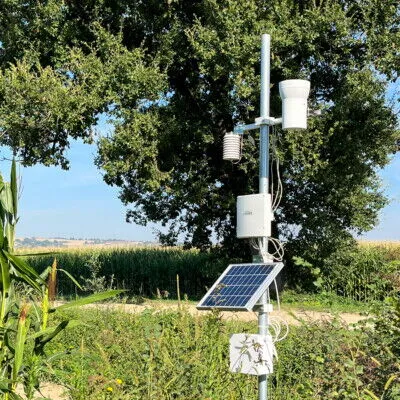In the face of growing global challenges such as population growth, climate change, and resource scarcity, the agricultural sector is under immense pressure to innovate and optimize. To meet the rising demand for food while ensuring sustainability, farmers are turning to advanced technologies, with agricultural sensors emerging as a game-changer. These sensors provide real-time data to enhance decision-making, improve efficiency, and minimize resource wastage.
Acting as the "eyes and ears" of modern farming, agricultural sensors offer valuable insights into environmental conditions, soil health, crop growth, and machinery performance. By integrating these sensors with smart farming technologies, such as IoT (Internet of Things), AI (Artificial Intelligence), and machine learning, farmers can achieve unprecedented precision in managing their operations.
This article explores the role of agricultural sensors, their various types, and their transformative impact on modern farming practices.

Agricultural sensors are electronic devices designed to detect physical, chemical, or biological changes in the farming environment and convert them into measurable data. This data can then be used to inform farming decisions, automate processes, and optimize agricultural practices.
With the global population projected to reach nearly 10 billion by 2050, food production needs to increase substantially. However, climate change, soil degradation, and water scarcity pose significant threats to agriculture. Agricultural sensors help mitigate these challenges by providing precise, data-driven insights that empower farmers to adopt more efficient and sustainable farming methods.
By monitoring soil health, crop conditions, and environmental factors, sensors enable farmers to optimize yields.
Precision irrigation, fertilization, and pesticide application help conserve water, reduce chemical use, and minimize waste.
Automated data collection and analysis reduce labor costs while improving decision-making.
Sustainable practices supported by sensor data can minimize the ecological impact of farming.
Agricultural sensors come in various forms, each serving a specific purpose in modern farming. Below are some of the most widely used sensor types:
These sensors use GPS (Global Positioning System) technology to provide precise spatial data about fields and assets.
Mapping farmland to delineate boundaries and variations in soil quality
Tracking the movement of agricultural machinery and equipment
Optimizing planting patterns based on topographical data
By leveraging GPS technology, farmers can implement precision agriculture, a practice that optimizes field management based on location-based data.
Soil moisture sensors measure the water content in the soil by analyzing its dielectric properties, which affect its ability to hold an electrical charge.
Monitoring soil moisture levels to determine optimal irrigation schedules
Preventing overwatering and waterlogging, which can lead to root diseases
Enhancing water conservation efforts by applying water only when necessary
Using these sensors, farmers can implement smart irrigation systems that maximize crop hydration while minimizing water wastage.
Optical sensors utilize light waves to assess plant health by measuring chlorophyll levels, light reflectance, and absorption.
Detecting nutrient deficiencies and plant stress at an early stage
Monitoring crop health using drones and remote sensing technologies
Supporting precision fertilizer application based on real-time crop needs
By analyzing data from optical sensors, farmers can improve crop quality and yield while reducing excessive use of fertilizers.
These sensors measure air temperature and humidity levels, helping farmers understand microclimate conditions in greenhouses and open fields.
Controlling greenhouse environments for optimal plant growth
Predicting frost or extreme heat conditions to take preventive measures
Regulating humidity to prevent fungal diseases and pest infestations
Nutrient sensors analyze soil composition, detecting levels of essential nutrients such as nitrogen (N), phosphorus (P), and potassium (K).
Guiding farmers on when and how much fertilizer to apply
Reducing excessive fertilizer use, which can lead to soil degradation
Enhancing precision nutrient management for healthier crops
Modern combine harvesters are equipped with sensors that weigh and geolocate harvested grain, creating yield maps that provide insights into productivity variations across fields.
Benefits: Farmers can identify high- and low-performing areas, optimizing crop management strategies.
Proximal sensors detect soil nutrient levels and guide machinery in applying fertilizers at variable rates.
Benefits: Reduces fertilizer waste, lowers costs, and prevents soil contamination.
Soil moisture sensors, combined with automated irrigation systems, ensure that crops receive the right amount of water at the right time.
Benefits: Water conservation, reduced crop stress, and higher-quality yields.
Drones equipped with multispectral cameras and optical sensors can scan entire fields for signs of disease, pests, or nutrient deficiencies.
Benefits: Early detection prevents widespread crop damage, improving productivity.
Wearable sensors track animal health by measuring body temperature, movement, and heart rate.
Benefits: Improves animal welfare, reduces mortality rates, and enhances livestock productivity.
As technology continues to evolve, agricultural sensors are becoming more sophisticated, cost-effective, and widely accessible. Emerging trends shaping the future of smart farming include:
IoT-enabled sensors can transmit data to cloud platforms in real-time, allowing farmers to monitor their fields remotely. This connectivity helps in automation, predictive analytics, and resource optimization.
AI algorithms analyze sensor data to predict weather patterns, disease outbreaks, and optimal harvesting times. These insights enable data-driven farming decisions that improve efficiency.
Agricultural sensors are being integrated into self-driving tractors, robotic planters, and automated irrigation systems, reducing labor costs while increasing accuracy in farming operations.
With the increasing use of sensors in agriculture, blockchain technology ensures secure and transparent data management, preventing data tampering and ensuring reliable farm records.
Agricultural sensors are revolutionizing modern farming by providing real-time, data-driven insights that enhance productivity, sustainability, and efficiency. From precision irrigation and fertilization to crop health monitoring and livestock management, these sensors empower farmers to optimize their operations with unprecedented accuracy.
As the global demand for food rises and environmental challenges intensify, embracing smart farming technologies will be crucial for ensuring food security, conserving resources, and promoting sustainable agricultural practices. By integrating sensors with AI, IoT, and automation, the future of farming is set to become more resilient, efficient, and environmentally friendly.
Previous: How Does A Carbon Dioxide Sensor Work?
Next: How to Test Home Air Quality: A Guide to a Healthier Living Environment




